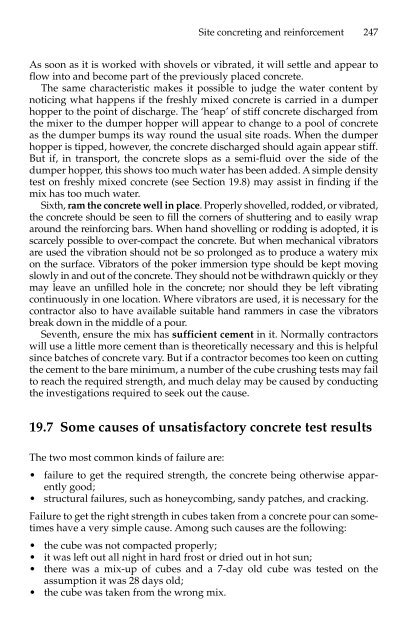Civil Engineering Project Management (4th Edition)
You also want an ePaper? Increase the reach of your titles
YUMPU automatically turns print PDFs into web optimized ePapers that Google loves.
Site concreting and reinforcement 247<br />
As soon as it is worked with shovels or vibrated, it will settle and appear to<br />
flow into and become part of the previously placed concrete.<br />
The same characteristic makes it possible to judge the water content by<br />
noticing what happens if the freshly mixed concrete is carried in a dumper<br />
hopper to the point of discharge. The ‘heap’ of stiff concrete discharged from<br />
the mixer to the dumper hopper will appear to change to a pool of concrete<br />
as the dumper bumps its way round the usual site roads. When the dumper<br />
hopper is tipped, however, the concrete discharged should again appear stiff.<br />
But if, in transport, the concrete slops as a semi-fluid over the side of the<br />
dumper hopper, this shows too much water has been added. A simple density<br />
test on freshly mixed concrete (see Section 19.8) may assist in finding if the<br />
mix has too much water.<br />
Sixth, ram the concrete well in place. Properly shovelled, rodded, or vibrated,<br />
the concrete should be seen to fill the corners of shuttering and to easily wrap<br />
around the reinforcing bars. When hand shovelling or rodding is adopted, it is<br />
scarcely possible to over-compact the concrete. But when mechanical vibrators<br />
are used the vibration should not be so prolonged as to produce a watery mix<br />
on the surface. Vibrators of the poker immersion type should be kept moving<br />
slowly in and out of the concrete. They should not be withdrawn quickly or they<br />
may leave an unfilled hole in the concrete; nor should they be left vibrating<br />
continuously in one location. Where vibrators are used, it is necessary for the<br />
contractor also to have available suitable hand rammers in case the vibrators<br />
break down in the middle of a pour.<br />
Seventh, ensure the mix has sufficient cement in it. Normally contractors<br />
will use a little more cement than is theoretically necessary and this is helpful<br />
since batches of concrete vary. But if a contractor becomes too keen on cutting<br />
the cement to the bare minimum, a number of the cube crushing tests may fail<br />
to reach the required strength, and much delay may be caused by conducting<br />
the investigations required to seek out the cause.<br />
19.7 Some causes of unsatisfactory concrete test results<br />
The two most common kinds of failure are:<br />
• failure to get the required strength, the concrete being otherwise apparently<br />
good;<br />
• structural failures, such as honeycombing, sandy patches, and cracking.<br />
Failure to get the right strength in cubes taken from a concrete pour can sometimes<br />
have a very simple cause. Among such causes are the following:<br />
• the cube was not compacted properly;<br />
• it was left out all night in hard frost or dried out in hot sun;<br />
• there was a mix-up of cubes and a 7-day old cube was tested on the<br />
assumption it was 28 days old;<br />
• the cube was taken from the wrong mix.


















